Geographic Information System Based Suitable Temporary Shelter Location for Mount Merapi Eruption
Abstract
:1. Introduction
2. Literature Review
3. Research Methodology
4. Research Result
4.1. Shelter Criteria for the Merapi Eruption
- 1.
- The location of the shelter can be in the hazard zone, with a maximum limit of 500 m from the hazard zone boundary. If the location of the shelter in meters is x then
- 2.
- The location of the shelter can be in an area with less than a safety radius, with a maximum limit of 1000 m from the safety radius. If the location of the shelter in meters is x, then
4.2. Candidate Shelters for the Merapi Eruption
4.3. Fuzzy Membership Value
4.4. Analytical Hierarchy Process
4.5. Potential Shelter
5. Discussion
6. Conclusions
Author Contributions
Funding
Institutional Review Board Statement
Informed Consent Statement
Data Availability Statement
Conflicts of Interest
References
- Voight, B.; Constantine, E.K.; Siswowidjoyo, S.; Torley, R. Historical Eruptions of Merapi Volcano, Central Java, Indonesia. J. Volcanol. Geotherm. Res. 2000, 100, 69–138. [Google Scholar] [CrossRef]
- Mei, E.T.W.; Lavigne, F. Mass Evacuation of the 2010 Merapi Eruption. Int. J. Emerg. Manag. 2013, 9, 298–311. [Google Scholar] [CrossRef]
- Newhall, C.G.; Bronto, S.; Alloway, B.; Banks, N.G.; Bahar, I. 10,000 Years of Explosive Eruptions of Merapi Volcano, Central Java: Archaeological and Modern Implications. J. Volcanol. Geotherm. Res. 2000, 100, 9–50. [Google Scholar] [CrossRef]
- Mei, E.T.W.; Lavigne, F.; Picquout, A.; de Bélizal, E.; Brunstein, D.; Grancher, D.; Sartohadi, J.; Cholik, N.; Vidal, C. Lessons Learned from the 2010 Evacuations at Merapi Volcano. J. Volcanol. Geotherm. Res. 2013, 261, 348–365. [Google Scholar] [CrossRef]
- Jumadi Carver, S.J.; Quincey, D.J. A Conceptual Design of Spatio-Temporal Agent-Based Model for Volcanic Evacuation. Systems 2017, 5, 53. [Google Scholar] [CrossRef] [Green Version]
- BPBD Sleman. Laporan Tanggap Darurat Erupsi Merapi 2010; Pemerintah Kabupaten Sleman: Sleman, Indonesia, 2011. [Google Scholar]
- Al Garni, H.Z.; Awasthi, A. Solar PV Power Plants Site Selection: A Review. Adv. Renew. Energ. Power Technol. 2018, 1, 57–75. [Google Scholar] [CrossRef]
- Wigati, S.S.; Sopha, B.M.; Asih, A.M.S.; Sutanta, H. Bibliometric Analysis for Site Selection Problems Using Geographic Information Systems, Multi-Criteria Decision Analysis and Fuzzy Method. URICSE J. Phys. Conf. Ser. 2019, 1351, 012051. [Google Scholar] [CrossRef]
- Muneer, A.S.; Sayl, K.N.; Kamal, A.H. Modeling of spatially distributed infiltration in the Iraqi Western Desert. Appl. Geomat. 2021, 13, 467–479. [Google Scholar] [CrossRef]
- Rikalović, A.; Cocić, I. GIS Based Multi-Criteria Decision Analysis for Industrial Site Selection: The State of the Art. J. Appl. Eng. Sci. 2014, 12, 197–206. [Google Scholar] [CrossRef] [Green Version]
- Rediske, G.; Siluk, J.C.M.; Gastaldo, M.G.; Rigo, P.D.; Rosa, C.B. Determinant Factors in Site Selection for Photovoltaic Projects: A Systematic Review. Int. J. Energy Res. 2018, 1–13. [Google Scholar] [CrossRef]
- Lokhande, T.I.; Mane, S.J.; Mali, S.T. Landfill Site Selection using GIS and MCDA Methods: A Review. Int. J. Res. Eng. Sci. Technol. 2017, 3, 25–30. [Google Scholar]
- Abujayyab, S.K.M.; Sanusi, M.S.; Yahya, A.S.; Alslaibi, T. GIS Modeling for Landfill Site Selection via Multi-Criteria Decision Analysis: A Systematic Review. In Proceedings of the International Conference on High Performance Compilation, Computing and Communications, Kuala Lumpur, Indonesia, 22–24 March 2017. [Google Scholar] [CrossRef]
- Hashim, H.Q.; Sayl, K.N. The application of radial basis network model, GIS, and spectral reflectance band recognition for runoff calculation. Int. J. Des. Nat. Ecodynamics 2020, 15, 441–447. [Google Scholar] [CrossRef]
- Muneer, A.S.; Sayl, K.N.; Kamel, A.H. Modeling of runoff in the arid regions using remote sensing and geographic information system (GIS). Int. J. Des. Nat. Ecodynamics 2020, 15, 691–700. [Google Scholar] [CrossRef]
- Ma, Y.; Xu, W.; Qin, L.; Zhao, X. Site Selection Models in Natural Disaster Shelters: A Review. Sustainability 2019, 11, 399. [Google Scholar] [CrossRef] [Green Version]
- Sanyal, J.; Lu, X.X. Ideal Location for Flood Shelter: A Geographic Information System Approach. J. Flood Risk Manag. 2009, 2, 262–271. [Google Scholar] [CrossRef]
- Tai, C.; Lee, Y.; Lin, C. Earthquake Evacuation Shelter Feasibility Analysis Applying with GIS Model Builder. In Proceedings of the 40th International Conference on Computers & Industrial Engineering, CIE40, Awaji, Japan, 25–28 July 2010. [Google Scholar] [CrossRef]
- Chen, W.; Zhai, G.; Ren, C.; Shi, Y.; Zhang, J. Urban Resources Selection and Allocation for Emergency Shelters: In a Multi-Hazard Environment. Int. J. Environ. Res. Public Health 2018, 15, 1261. [Google Scholar] [CrossRef] [Green Version]
- Nakai, H.; Itatani, T.; Horiike, R.; Kyota, K.; Tsukasaki, K. Tsunami Evacuation Simulation Using Geographic Information Systems for Homecare Recipients Depending on Electric Devices. PLoS ONE 2018, 13, 1–18. [Google Scholar] [CrossRef] [Green Version]
- Shan, B.; Wang, K.; Wang, L. Optimal Location of Urban Seismic Shelter for Evacuation Based on Network Analysis of GIS. In Proceedings of the IEEE 3rd International Conference on Cloud Computing and Big Data Analysis, Chengdu, China, 20–22 April 2018; pp. 532–536. [Google Scholar] [CrossRef]
- Huang, Y.; Yin, Z.; Chu, H. Suitability Assessment of Emergency Shelters Based on GIS: A Case Study in Urban Function Optimization Area of Shanghai. In Proceedings of the IOP Conference Series: Earth and Environmental Science, Hubei, China, 14–16 December 2018; Volume 234, p. 012039. [Google Scholar] [CrossRef]
- Kar BHodgson, M.E. A GIS-based Model to Determine Site Suitability of Emergency Evacuation Shelters. Trans. GIS 2018, 12, 227–248. [Google Scholar] [CrossRef]
- Tsai, C.H.; Chen, C.W.; Chiang, W.L.; Lin, M.L. Application of geographic information system to the allocation of disaster shelters via fuzzy models. Eng. Comput. 2008, 25, 86–100. [Google Scholar] [CrossRef]
- Chu, J.Y.; Su, Y.P. Comprehensive Evaluation Index System in the Application for Earthquake Emergency Shelter Site. Adv. Mater. Res. 2011, 156, 79–83. [Google Scholar] [CrossRef]
- Chu, J.; Su, Y. The Application of TOPSIS Method in Selecting Fixed Seismic Shelter for Evacuation in Cities. Syst. Eng. Procedia 2012, 3, 391–397. [Google Scholar] [CrossRef] [Green Version]
- Cheng, H.; Yang, X.K. The Comprehensive Evaluation Model for Earthquake Emergency Shelter. Sustainable Transportation Systems: Plan, Design, Build, Manage, and Maintenance. In Proceedings of the Ninth Asia Pacific Transportation Development Conference, Chongqing, China, 29 June–1 July 2012; pp. 412–422. [Google Scholar] [CrossRef]
- Tong, Z.; Zhang, J.; Liu, X. GIS-Based Design of Urban Emergency Shelter in Songbei Harbin. Lect. Notes Electr. Eng. 2012, 129, 617–622. [Google Scholar] [CrossRef]
- Givechi, S.; Attar, M.A.; Rashidi, A.; Nasbi, N. Site Selection of Temporary Housing After Earthquake by GIS and AHP Method Case Study: Region 6 of Shiraz Urban-Regional. J. Urban-Reg. Stud. Res. 2013, 5, 29–32. [Google Scholar]
- Yu, J.; Wen, J. Multi-criteria Satisfaction Assessment of the Spatial Distribution of Urban Emergency Shelters Based on High-Precision Population Estimation. Int. J. Disaster Risk Sci. 2016, 7, 413–429. [Google Scholar] [CrossRef] [Green Version]
- Dou, K.; Zhan, Q.; Li, S. GIS-based Responsibility Area Subdivision for Metropolitan Emergency Shelters: Case Study of Wuchang District, Wuhan City. In Proceedings of the 6th International Association for China Planning Conference, Wuhan, China, 17–19 June 2012. [Google Scholar] [CrossRef]
- Omidvar, B.; Baradaran-Shoraka, M.; Nojavan, M. Temporary Site Selection and Decision-Making Methods: A Case Study of Tehran, Iran. Disaster 2013, 37, 536–553. [Google Scholar] [CrossRef] [PubMed]
- Anhorn, J.; Khazai, B. Open Space Suitability Analysis for Emergency Shelter After an Earthquake. Nat. Hazards Earth Syst. Sci. 2015, 15, 789–803. [Google Scholar] [CrossRef] [Green Version]
- Esmaelian, M.; Tavana, M.; Arteaga, F.J.S. A Multicriteria Spatial Decision Support System for Solving Emergency Service Station Location Problems. Int. J. Geogr. Inf. Sci. 2015, 29, 37–41. [Google Scholar] [CrossRef]
- Junian, J.; Azizifar, V. The Evaluation of Temporary Shelter Areas Locations Using Geographic Information System and Analytic Hierarchy Process. Civ. Eng. J. 2018, 4, 1678–1688. [Google Scholar] [CrossRef]
- Asadi, M.; Karami, J. Spatial Optimization of Safe Shelters for Urban Evacuation Planning Caused by Earthquake Based on PROMETHEE, GAIA and DEA Method in GIS Environment (Case Study: Municipal District 12 of Tehran). Disaster Adv. 2019, 12, 37–45. [Google Scholar]
- Shi, Y.; Zhai, G.; Xu, L.; Zhu, Q.; Deng, J. Planning Emergency Shelters for Urban Disasters: A Multi-Level Location–Allocation Modeling Approach. Sustainability 2019, 11, 4285. [Google Scholar] [CrossRef] [Green Version]
- Khudhair, M.A.; Sayl, K.N.; Darama, Y. Locating Site Selection for Rainwater Harvesting Structure using Remote Sensing and GIS. IOP Conf. Ser. Mater. Sci. Eng. 2020, 881, 012170. [Google Scholar] [CrossRef]
- Alçada-Almeida, L.; Tralhao, L.; Santos, L.; Coutinho-Rodrigues, J. A Multiobjective Approach to Locate Emergency Shelters and Identify Evacuation Routes in Urban Areas. Geogr. Anal. 2009, 41, 9–29. [Google Scholar] [CrossRef]
- Sayl, K.N.; Sulaiman, S.O.; Kamel, A.H.; Muhammad, N.S.; Abdullah, J.; Al-Ansari, N. Minimizing the Impacts of Desertification in an Arid Region: A Case Study of the West Desert of Iraq. Adv. Civ. Eng. 2021, 2021, 5580286. [Google Scholar] [CrossRef]
- Melo, A.L.O.; Calijuri, M.L.; Duarte, I.C.D.; Azevedo, R.F.; Lorentz, J.F. Strategic Decision Analysis for Selection of Landfill Sites. J. Surv. Eng. 2006, 132, 83–92. [Google Scholar] [CrossRef]
- Zadeh, L.A. Fuzzy Sets. Inf. Control. 1965, 8, 338–353. [Google Scholar] [CrossRef] [Green Version]
- Malczewski, J. Review Article on the Use of Weighted Linear Combination Method in GIS: Common and Best Practice Approaches. Trans. GIS 2000, 4, 5–22. [Google Scholar] [CrossRef]
- Drobne, S.; Lisec, A. Multi-attribute Decision Analysis in GIS: Weighted Linear Combination and Ordered Weighted Averaging. Informatica 2009, 33, 459–474. [Google Scholar]
- Saaty, T.L. A Scaling Method for Priorities in Hierarchical Structures. J. Math. Psychol. 1977, 15, 234–281. [Google Scholar] [CrossRef]
- Hadisantono, R.D.; Andreastuti, S.; Abdurachman, E.; Sayudi, D.; Nurnusanto, I.; Martono, A. Peta Kawasan Rawan Bencana Gunungapi Merapi, Jawa Tengah dan Daerah Istimewa Yogyakarta (Volcanic Hazard Map of Merapi Volcano, Central Java and Yogyakarta Special Province); Center for Volcanology and Geological Hazard Mitigation: Bandung, Indonesia, 2002. [Google Scholar]
- Sayudi, D.S.; Nurnaning, A.; Juliani, D.J.; Muzani, M. Peta Kawasan Rawan Bencana Gunungapi Merapi, Jawa Tengah dan Daerah Istimewa Yogyakarta 2010 (Merapi Hazard Map, Central Java and Yogyakarta Special Region Provinces 2010); Pusat Vulkanologi dan Mitigasi Bencana Geologi: Bandung, Indonesia, 2010. [Google Scholar]
- Vaidya, O.S.; Kumar, S. Analytic Hierarchy Process: An Overview of Applications. Eur. J. Oper. Res. 2006, 169, 1–29. [Google Scholar] [CrossRef]
- Ahmed, A.; Mahmoud, H.; Aly, A. Site Suitability Evaluation for Sustainable Distribution of Hospital Using Spatial Information Technologies and AHP: A Case Study of Upper Egypt, Aswan City. J. Geogr. Inf. Syst. 2016, 8, 578–594. [Google Scholar] [CrossRef] [Green Version]
- Nappi, M.M.L.; Souza, J.C. Disaster management: Hierarchical structuring criteria for selection and location of temporary shelters. Nat. Hazards 2015, 75, 2421–2436. [Google Scholar] [CrossRef]
- Liu, Q.; Ruan, X.; Shi, P. Selection of emergency shelter sites for seismic disasters in mountainous regions: Lessons from the 2008 Wenchuan Ms 8.0 Earthquake, China. J. Asian Earth Sci. 2011, 40, 926–934. [Google Scholar] [CrossRef]
- Soltani, A.; Ardalan, A.; Boloorani, A.D.; Haghdoost, A.; Hosseinzadeh-Attar, M.J. Criteria for Site Selection of Temporary Shelters after Earthquakes: A Delphi Panel. PLoS Curr. Disasters 2015, 7. [Google Scholar] [CrossRef] [PubMed]
- Tsai, C.; Yeh, Y. The study of integrating geographic information with multi-objective decision making on allocating the appropriate refuge shelters: Using Kengting National Park as an example. Nat. Hazards 2016, 82, 2133–2147. [Google Scholar] [CrossRef]
- Kilci, F.; Kara, B.Y.; Bozkaya, B. Locating Temporary Shelter Areas after an Earthquake: A Case for Istanbul. Eur. J. Oper. Res. 2015, 242, 323–332. [Google Scholar] [CrossRef]
- Trivedi, A.; Singh, A. A hybrid multi-objective decision model for emergency shelter location-relocation projects using fuzzy analytic hierarchy process and goal programming approach. Int. J. Proj. Manag. 2017, 35, 827–840. [Google Scholar] [CrossRef]
- Trivedi, A. A multi-criteria decision approach based on DEMATEL to assess determinants of shelter site selection in disaster response. Int. J. Disaster Risk Reduct. 2018, 31, 722–728. [Google Scholar] [CrossRef]
- Geng, S.; Hou, H.; Zhang, S. Multi-Criteria Location Model of Emergency Shelters in Humanitarian Logistics. Sustainability 2020, 12, 1759. [Google Scholar] [CrossRef] [Green Version]
- Chanta, S.; Sangsawang, O. Shelter-Site Selection During Flood Disaster. Lect. Notes Manag. Sci. 2012, 4, 282–288. [Google Scholar]
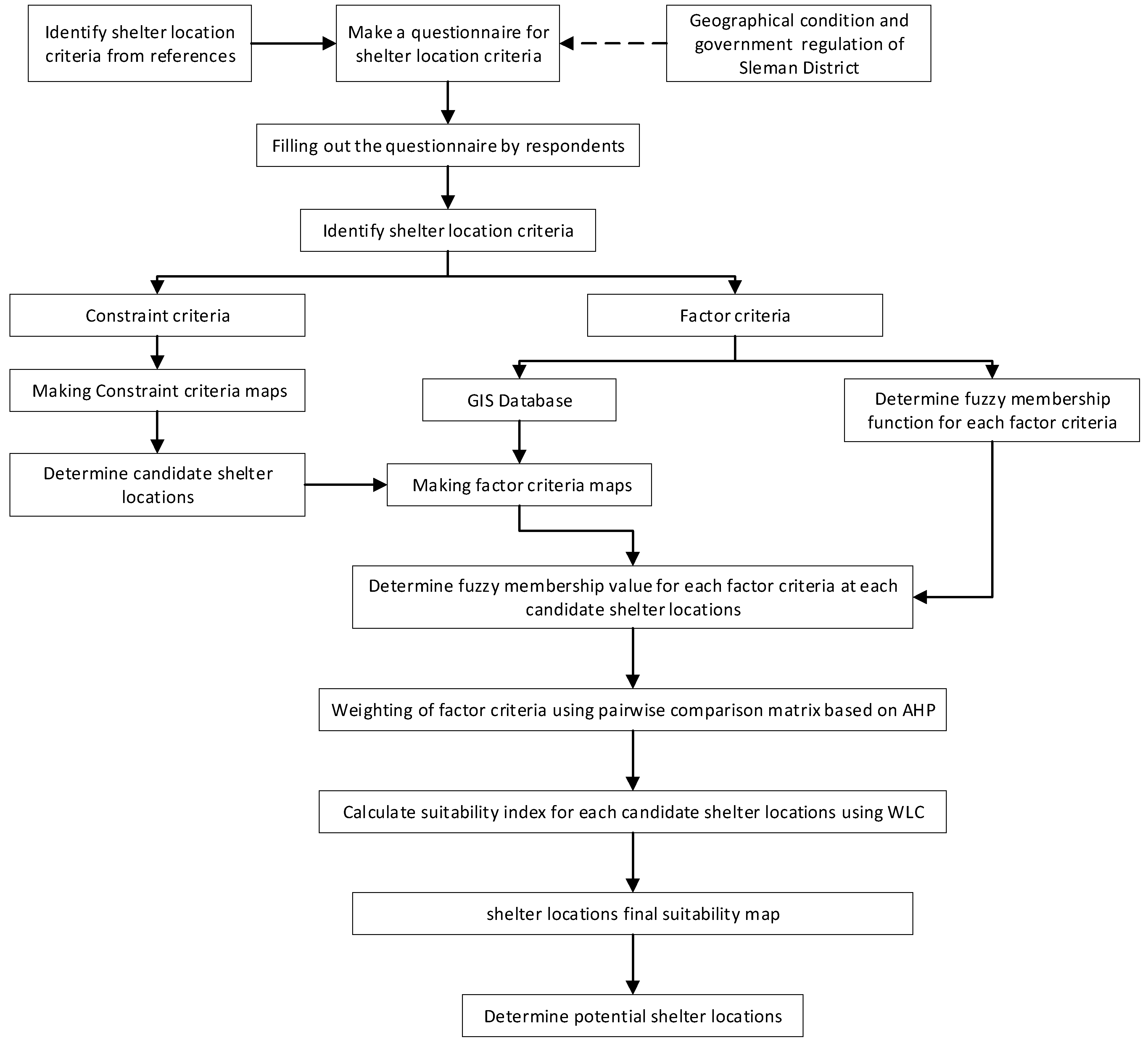
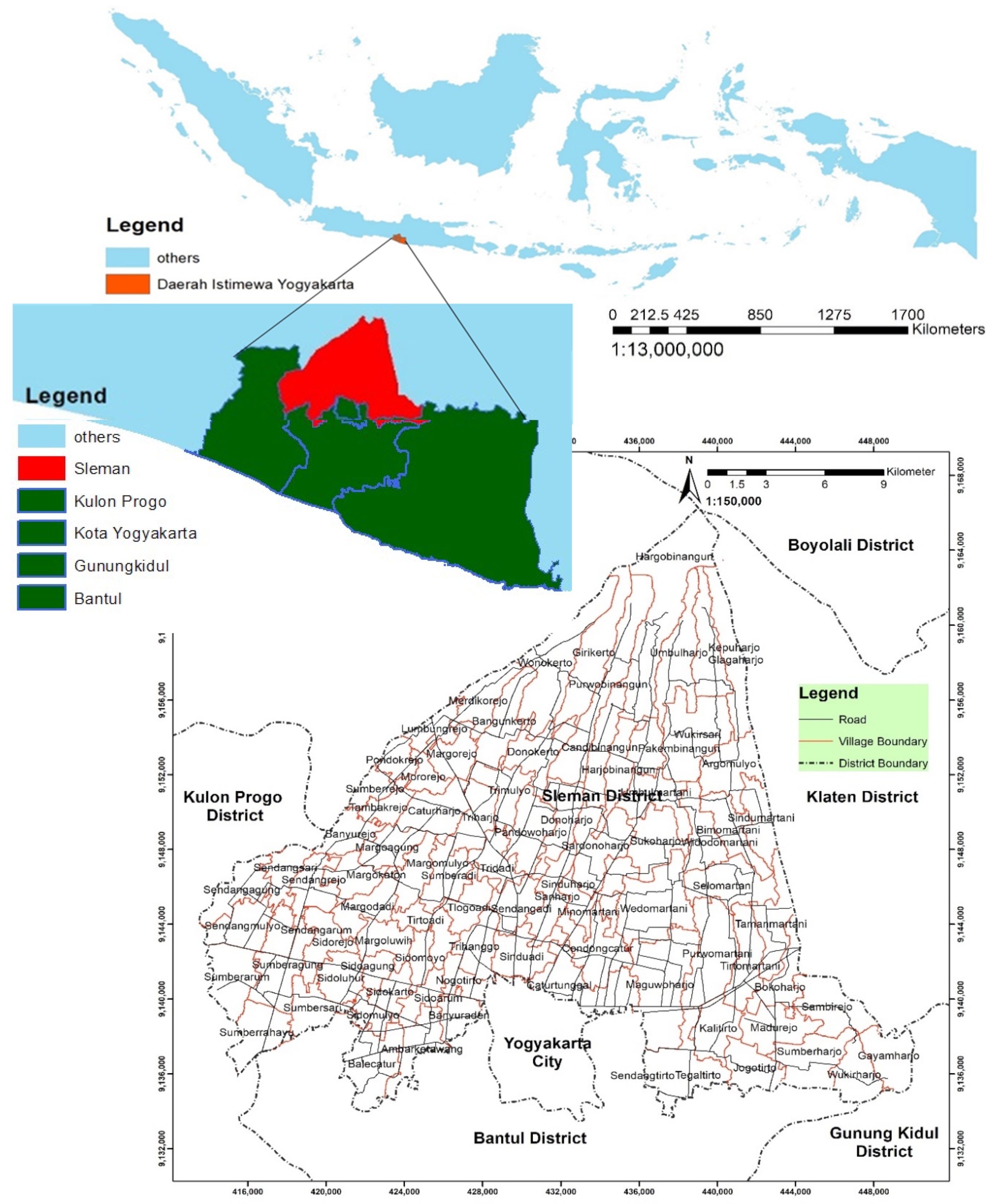
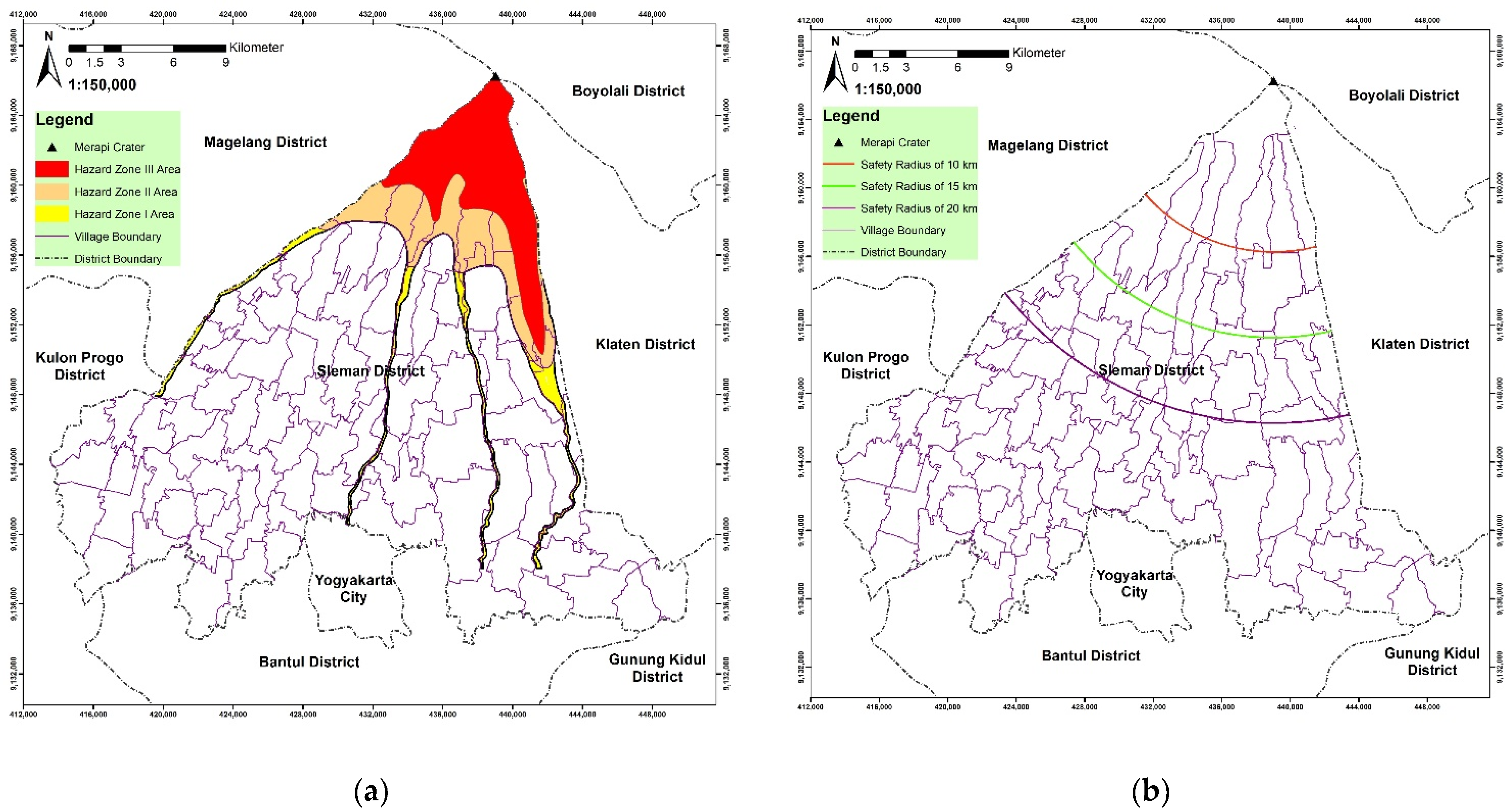
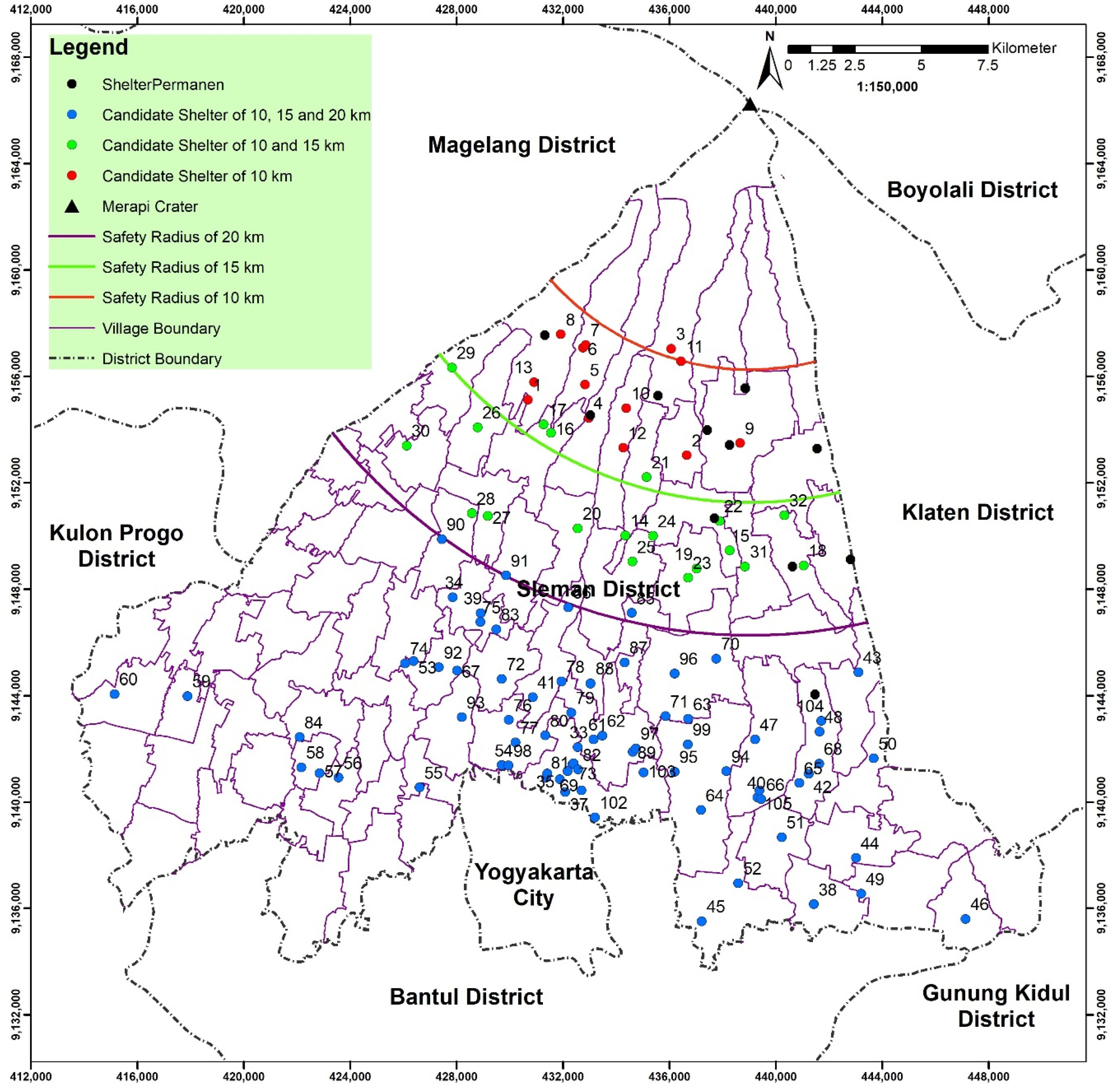
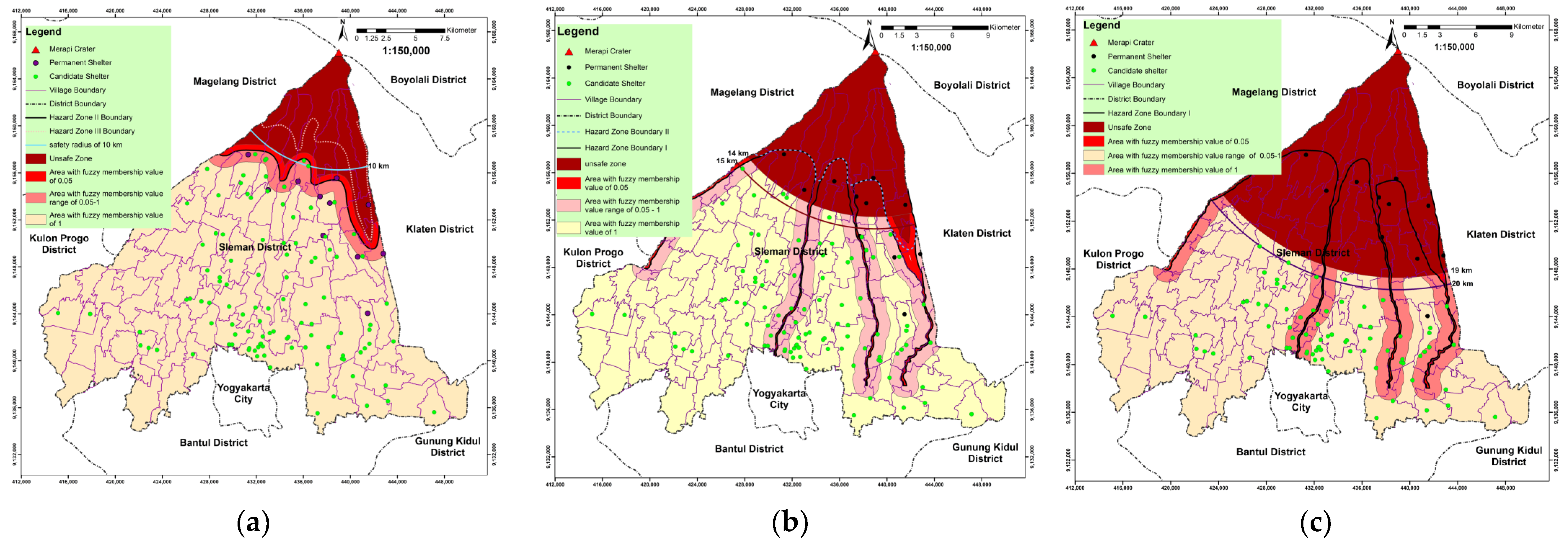


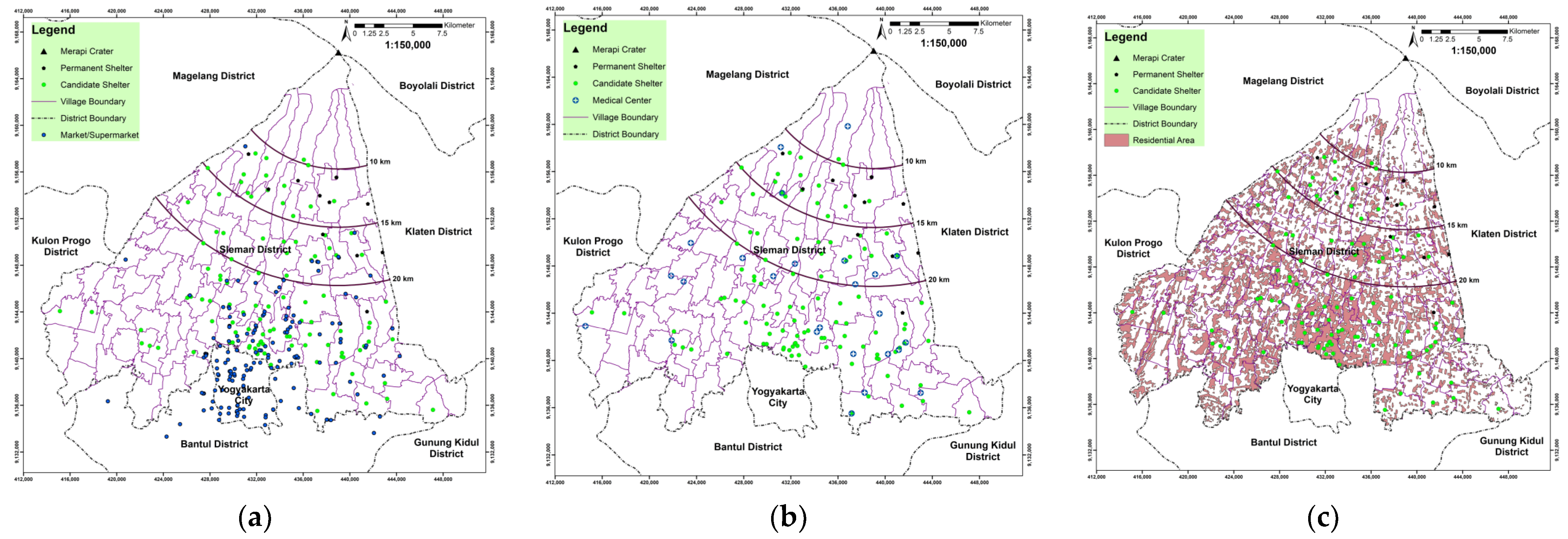
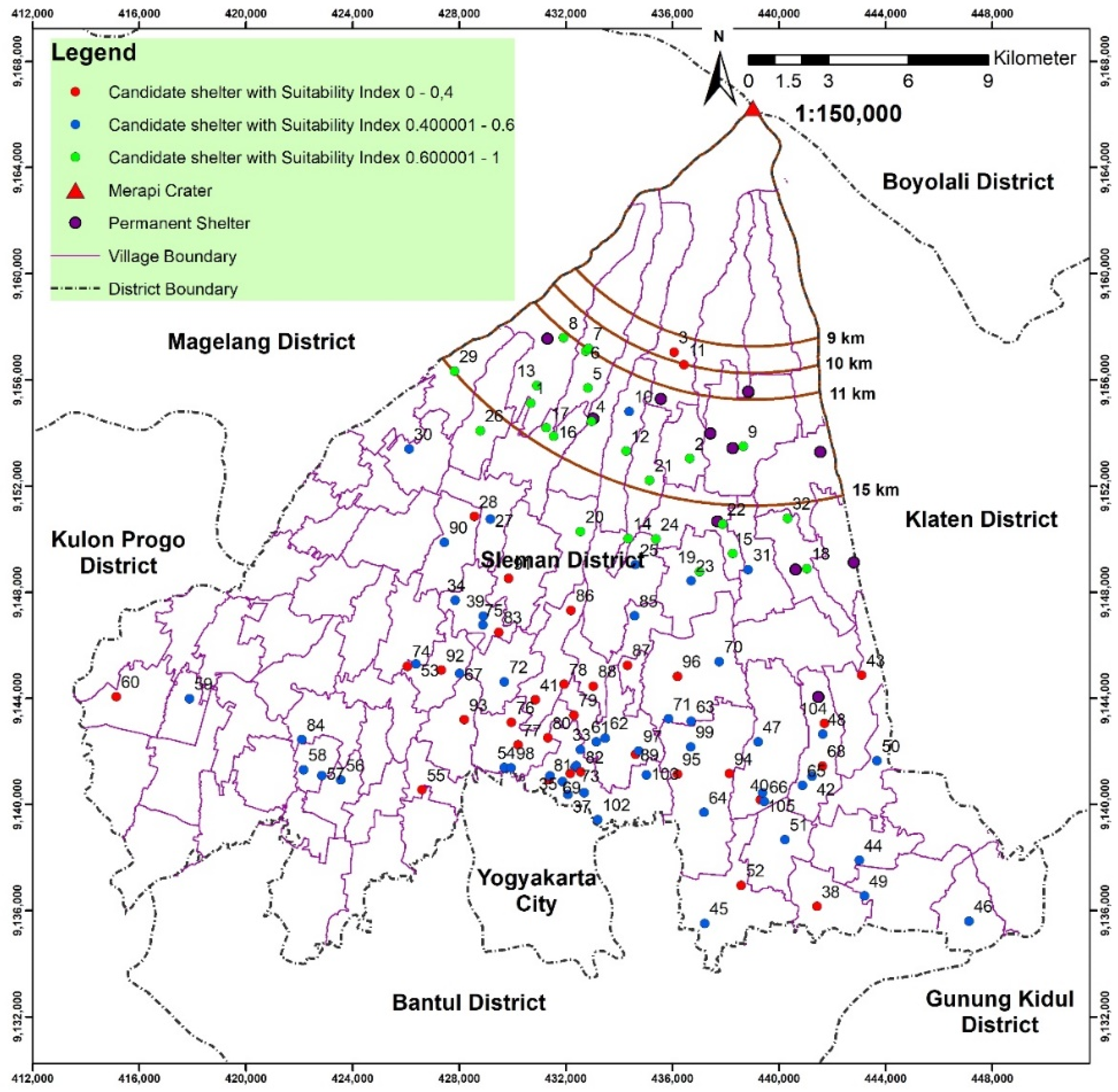
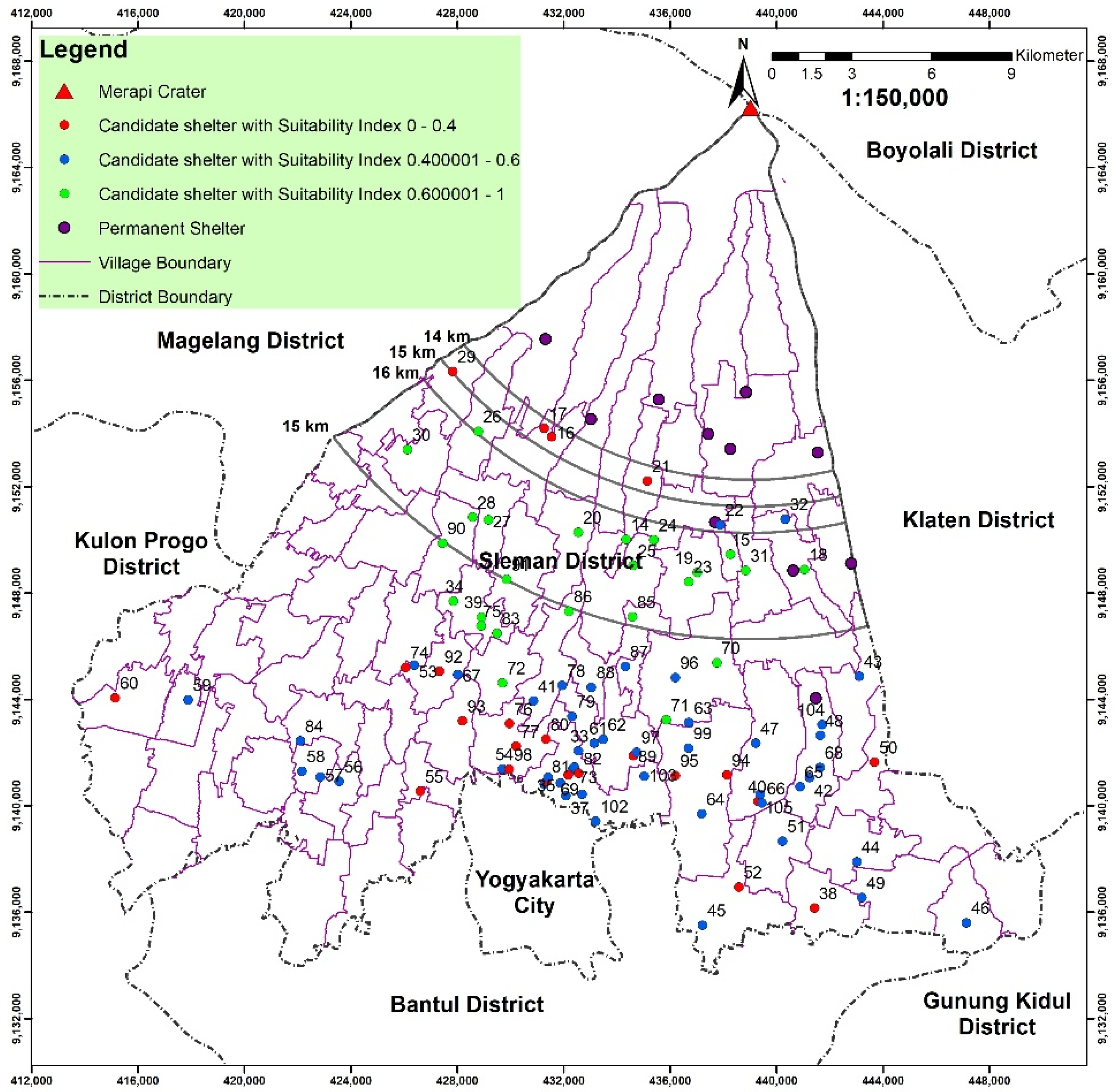
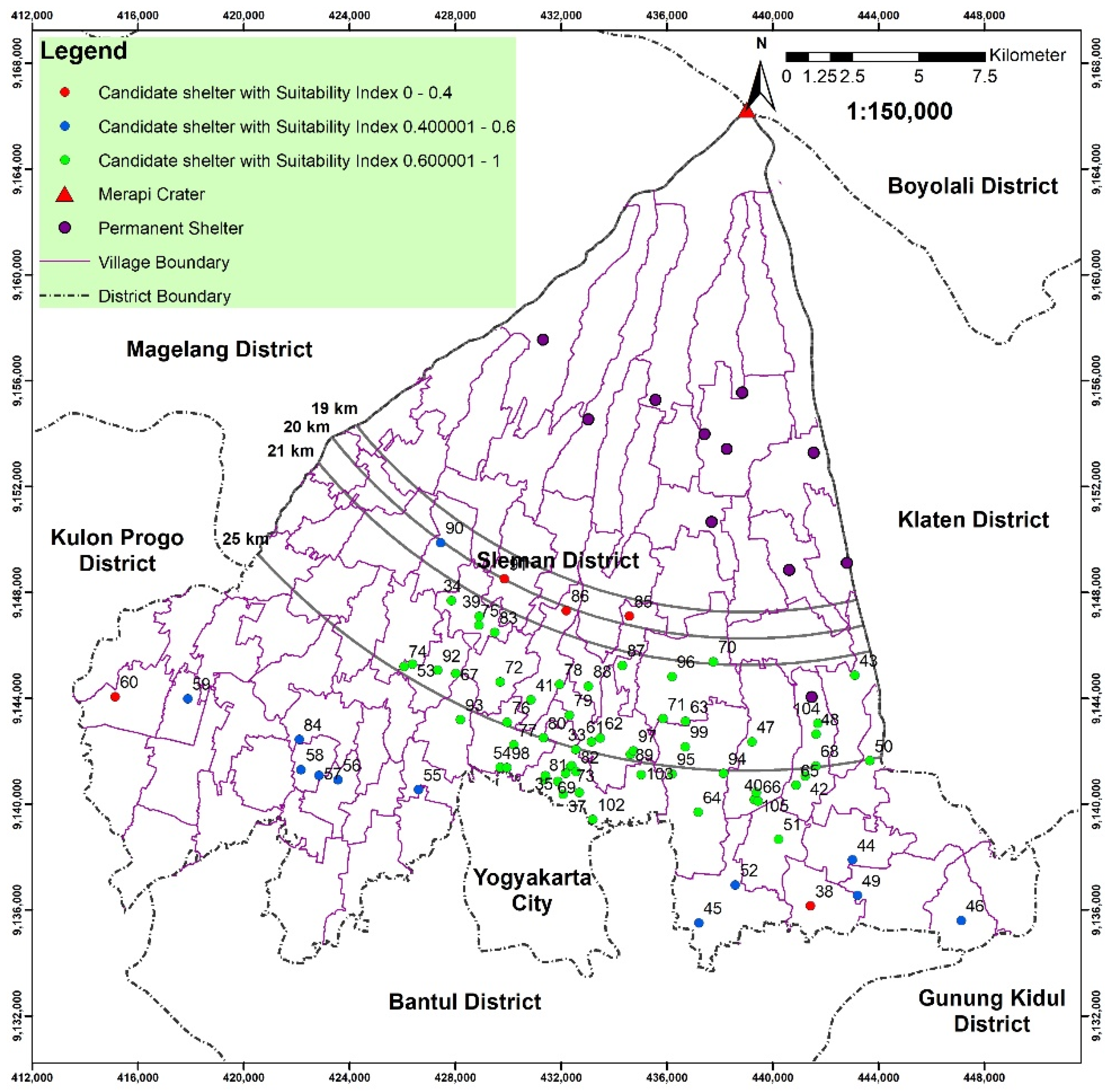
| Criteria | Sub-Criteria | Fuzzy Membership Function/Score |
|---|---|---|
| Disaster Risk | Hazard zone | x = distance of shelter candidate location from hazard zone boundary line in meters |
| Safety radius | x = distance of shelter candidate location from safety radius boundary line in meters | |
| Distance from river | x = distance of shelter candidate location from the river boundary in meters | |
| Land Suitability | Land use | |
| Accessibility | Distance from medical center/healthcare | x = distance shelter candidate location from medical center/healthcare in meters |
| Distance from market/supermarket | x = distance of candidate shelter location from market/supermarket in meters | |
| Distance from material reserve/warehouse | x = distance of shelter candidate location from material reserve/warehouse in meters | |
| Distance from a fire station | x = distance of shelter candidate location from a fire station in meters | |
| Security and protection | x = distance of shelter candidate location from police post/military post in meters | |
| Distance from residential area | x = distance of shelter candidate location from a residential area in meters | |
| Distance from road | x = distance of shelter candidate location from road boundary in meters | |
| Width of street | x = width of the street in meters | |
| Road connection/access connection | x = number of routes from the affected area to shelter candidate | |
| Infrastructure | Water resources | x = distance of shelter candidate location from water resources in meters |
| Electrical installation | x = distance of shelter candidate location from electrical installation in meters | |
| Sanitary system | x = distance of shelter candidate location from the sanitary system in meters | |
| Feasibility | Shelter area | x = shelter area of shelter candidate location in meter squares |
| Shelter capacity | x = shelter capacity | |
| Open space ratio | x = open space ratio |
| No. | Shelter Candidate | No. | Shelter Candidate |
|---|---|---|---|
| 1 | Gedung olah Raga (GOR) Gama Asri | 54 | Balai Desa Sinduadi |
| 2 | GOR Gambiran | 55 | Balai Desa Nogotirto |
| 3 | GOR Dusun Tanen | 56 | Koramil Godean |
| 4 | Kelurahan Purwobinangun | 57 | Kecamatan Godean |
| 5 | Lapangan Sepakbola Girikerto | 58 | Balai Desa Sidoagung |
| 6 | Gedung Serbaguna Girikerto | 59 | Balai Desa Sendangarum |
| 7 | Balai Desa Girikerto | 60 | Balai Desa Sendangmulyo |
| 8 | Balai Desa Wonokerto | 61 | Kecamatan Depok |
| 9 | Balai Desa Wukirsari | 62 | Balai Desa Condongcatur |
| 10 | Lapangan Cemorohardjo | 63 | Balai Pengkajian Teknologi Pertanian |
| 11 | Lapangan Panti Asih | 64 | Balai Desa Maguwoharjo |
| 12 | Balai Desa Candibinangun | 65 | Bapelkes Tirtomartani |
| 13 | Lapangan Punthuk | 66 | BULOG DIY GBB Purwomartani |
| 14 | GOR Badminton Turgogede | 67 | Youth Centre |
| 15 | GOR AYA | 68 | Lapangan Raden Ronggo |
| 16 | GOR Donokerto | 69 | Stadion Pancasila |
| 17 | Koramil 13 Turi | 70 | Balai Desa Wedomartani |
| 18 | Balai Desa Bimomartani | 71 | Stadion Maguwoharjo |
| 19 | PPPG Kesenian (PPPPTK Seni dan Budaya) | 72 | Balai Desa Sendangadi |
| 20 | Lapangan Donoharjo | 73 | Lapangan Klebengan |
| 21 | Lapangan Pojok | 74 | Lapangan Mlati Sleman |
| 22 | Lapangan Grogolan | 75 | Lapangan Pemda Sleman |
| 23 | Lapangan Klidon | 76 | Lapangan Sinduadi |
| 24 | Universitas Islam Indonesia | 77 | Lapangan Popongan |
| 25 | Lapangan Candiwinangun | 78 | Lapangan Lempongsari |
| 26 | Lapangan Ngablak | 79 | Lapangan Kentungan Yonif 403 |
| 27 | Balai Desa Trimulyo | 80 | Lapangan Pogung Baru |
| 28 | Lapangan Panasan | 81 | Lapangan Pancasila UGM |
| 29 | Lapangan Gimberan | 82 | Lapangan FT UNY |
| 30 | Lapangan Gundengan | 83 | Lapangan Denggung |
| 31 | Lapangan Sepakbola Jetis Jangkang | 84 | Balai Desa Margoluwih |
| 32 | PSAA Bimomartani | 85 | Lapangan Sepakbola Gadingan |
| 33 | GOR Badminton Gandok Mulya | 86 | Lapangan Sariharjo |
| 34 | GOR Tridadi | 87 | Lapangan Minomartani |
| 35 | GOR Lembah UGM | 88 | Lapangan Banteng |
| 36 | GOR Klebengan | 89 | Lapangan Gorongan |
| 37 | GOR Universitas Negeri Yogyakarta | 90 | Lapangan Murangan |
| 38 | Balai Desa Jogotirto | 91 | Lapangan Pandowoharjo |
| 39 | Balai Besar Latihan Ketransmigrasian Yogyakarta | 92 | Lapangan Getas |
| 40 | Balai Diklat Keuangan Yogyakarta | 93 | Lapangan Janabadra |
| 41 | Gedung Serbaguna | 94 | Lapangan Sembego |
| 42 | Kecamatan Kalasan | 95 | Lapangan Pugeran |
| 43 | Balai Desa Tamanmartani | 96 | Lapangan Kayen |
| 44 | Balai Desa Madurejo | 97 | UPN Veteran Ringroad Utara |
| 45 | Balai Desa Sendangtirto | 98 | Akademi MaritimYogyakarta (AMY) |
| 46 | Balai Desa Wukirharjo | 99 | INSTIPER Yogyakarta |
| 47 | Balai Desa Purwomartani | 100 | Universitas Sanata Darma |
| 48 | Balai Desa Tirtomartani | 101 | Graha Sabha Pramana UGM |
| 49 | Balai Desa Sumberharjo | 102 | UIN Sunan Kalijaga |
| 50 | Balai Desa Bokoharjo | 103 | STIE YKPN |
| 51 | Balai Desa Kalitirto | 104 | LPMP DIY |
| 52 | Balai Desa Tegaltirto | 105 | UKRIM (Universitas Kristen Imanuel) |
| 53 | Balai Desa Tlogoadi |
| Pairwise Comparison Matrix | Normalized Matrix | Criterion Weight | ||||||
|---|---|---|---|---|---|---|---|---|
| C11 | C12 | C13 | C11 | C12 | C13 | |||
| Hazard zone (C11) | 1 | 1/9 | 1 | C11 | 0.0909 | 0.0909 | 0.0909 | 0.0909 |
| Safety radius (C12) | 9 | 1 | 9 | C12 | 0.8182 | 0.8182 | 0.8182 | 0.8182 |
| Distance from the river (C13) | 1 | 1 | 1/9 | C13 | 0.0909 | 0.0909 | 0.0909 | 0.0909 |
| C31 | C32 | C33 | C34 | C35 | C36 | C37 | C38 | C39 | |
|---|---|---|---|---|---|---|---|---|---|
| Distance from the medical center (C31) | 1 | 1 | 5 | 5 | 3 | 1 | 3 | 1 | 3 |
| Distance from market/supermarket (C32) | 1 | 1 | 3 | 5 | 1 | 1 | 1 | 1 | 3 |
| Distance from material reserve/warehouse (C33) | 1/5 | 1/3 | 1 | 3 | 1/5 | 1/5 | 1/3 | 1/5 | 1 |
| Distance from the fire station (C34) | 1/5 | 1/5 | 1/3 | 1 | 1/5 | 1/5 | 1/3 | 1/5 | 1/3 |
| Security and protection (C35) | 1/3 | 1 | 5 | 5 | 1 | 1 | 3 | 1 | 3 |
| Distance from the residential area (C36) | 1 | 1 | 5 | 5 | 1 | 1 | 3 | 1 | 3 |
| Distance from the road (C37) | 1/3 | 1 | 3 | 3 | 1/3 | 1/3 | 1 | 1/3 | 1 |
| Width of the street (C38) | 1 | 1 | 5 | 5 | 1 | 1 | 3 | 1 | 3 |
| Road connection/access connection (C39) | 1/3 | 1/3 | 1 | 3 | 1/3 | 1/3 | 1 | 1/3 | 1 |
| C31 | C32 | C33 | C34 | C35 | C36 | C37 | C38 | C39 | Criterion Weight | |
|---|---|---|---|---|---|---|---|---|---|---|
| C31 | 0.1852 | 0.1456 | 0.1765 | 0.1429 | 0.3719 | 0.1648 | 0.1915 | 0.1648 | 0.1636 | 0.18965 |
| C32 | 0.1852 | 0.1456 | 0.1059 | 0.1429 | 0.1240 | 0.1648 | 0.0638 | 0.1648 | 0.1636 | 0.14007 |
| C33 | 0.0370 | 0.0485 | 0.0353 | 0.0857 | 0.0248 | 0.0330 | 0.0213 | 0.0330 | 0.0545 | 0.04146 |
| C34 | 0.0370 | 0.0291 | 0.0118 | 0.0286 | 0.0248 | 0.0330 | 0.0213 | 0.0330 | 0.0182 | 0.02630 |
| C35 | 0.0617 | 0.1456 | 0.1765 | 0.1429 | 0.1240 | 0.1648 | 0.1915 | 0.1648 | 0.1636 | 0.14838 |
| C36 | 0.1852 | 0.1456 | 0.1765 | 0.1429 | 0.1240 | 0.1648 | 0.1915 | 0.1648 | 0.1636 | 0.16210 |
| C37 | 0.0617 | 0.1456 | 0.1059 | 0.0857 | 0.0413 | 0.0549 | 0.0638 | 0.0549 | 0.0545 | 0.07428 |
| C38 | 0.1852 | 0.1456 | 0.1765 | 0.1429 | 0.1240 | 0.1648 | 0.1915 | 0.1648 | 0.1636 | 0.16210 |
| C39 | 0.0617 | 0.0485 | 0.0353 | 0.0857 | 0.0413 | 0.0549 | 0.0638 | 0.0549 | 0.0545 | 0.05565 |
| Pairwise Comparison Matrix | Normalized Matrix | Criterion Weight | ||||||
|---|---|---|---|---|---|---|---|---|
| C41 | C42 | C43 | C41 | C42 | C43 | |||
| Water resource (C41) | 1 | 5 | 3 | C41 | 0.6522 | 0.5556 | 0.6923 | 0.6333 |
| Electrical installation (C42) | 1/5 | 1 | 1/3 | C42 | 0.1304 | 0.1111 | 0.0769 | 0.1062 |
| Sanitary system (C43) | 1/3 | 3 | 1 | C43 | 0.2174 | 0.3333 | 0.2308 | 0.2605 |
| Pairwise Comparison Matrix | Normalized Matrix | Criterion Weight | ||||||
|---|---|---|---|---|---|---|---|---|
| C51 | C52 | C53 | C51 | C52 | C53 | |||
| Shelter area (C51) | 1 | 1/5 | 1/3 | C51 | 0.1111 | 0.1304 | 0.0769 | 0.1062 |
| Shelter capacity (C52) | 5 | 1 | 3 | C52 | 0.5556 | 0.6522 | 0.6923 | 0.6333 |
| Open space ratio (C53) | 3 | 1/3 | 1 | C53 | 0.3333 | 0.2174 | 0.2308 | 0.2605 |
| Pairwise Comparison Matrix | Normalized Matrix | Criterion Weight | ||||||||||
|---|---|---|---|---|---|---|---|---|---|---|---|---|
| C1 | C2 | C3 | C4 | C5 | C1 | C2 | C3 | C4 | C5 | |||
| Disaster Risk (C1) | 1 | 9 | 5 | 5 | 7 | C1 | 0.6046 | 0.3913 | 0.6637 | 0.6637 | 0.4884 | 0.5623 |
| Land suitability (C2) | 1/9 | 1 | 1/5 | 1/5 | 1/3 | C2 | 0.0672 | 0.0435 | 0.0265 | 0.0265 | 0.0233 | 0.0374 |
| Accessibility (C3) | 1/5 | 5 | 1 | 1 | 3 | C3 | 0.1209 | 0.2174 | 0.1327 | 0.1327 | 0.2093 | 0.1626 |
| Infrastructure (C4) | 1/5 | 5 | 1 | 1 | 3 | C4 | 0.1209 | 0.2174 | 0.1327 | 0.1327 | 0.2093 | 0.1626 |
| Feasibility (C5) | 1/7 | 3 | 1/3 | 1/3 | 1 | C5 | 0.0864 | 0.1304 | 0.0442 | 0.0442 | 0.0698 | 0.0750 |
| Suitability Level | SI |
|---|---|
| High | 0.600001–1 |
| Medium | 0.400001–0.6 |
| Low | 0–0.4 |
Disclaimer/Publisher’s Note: The statements, opinions and data contained in all publications are solely those of the individual author(s) and contributor(s) and not of MDPI and/or the editor(s). MDPI and/or the editor(s) disclaim responsibility for any injury to people or property resulting from any ideas, methods, instructions or products referred to in the content. |
© 2023 by the authors. Licensee MDPI, Basel, Switzerland. This article is an open access article distributed under the terms and conditions of the Creative Commons Attribution (CC BY) license (https://creativecommons.org/licenses/by/4.0/).
Share and Cite
Wigati, S.S.; Sopha, B.M.; Asih, A.M.S.; Sutanta, H. Geographic Information System Based Suitable Temporary Shelter Location for Mount Merapi Eruption. Sustainability 2023, 15, 2073. https://doi.org/10.3390/su15032073
Wigati SS, Sopha BM, Asih AMS, Sutanta H. Geographic Information System Based Suitable Temporary Shelter Location for Mount Merapi Eruption. Sustainability. 2023; 15(3):2073. https://doi.org/10.3390/su15032073
Chicago/Turabian StyleWigati, Slamet Setio, Bertha Maya Sopha, Anna Maria Sri Asih, and Heri Sutanta. 2023. "Geographic Information System Based Suitable Temporary Shelter Location for Mount Merapi Eruption" Sustainability 15, no. 3: 2073. https://doi.org/10.3390/su15032073






